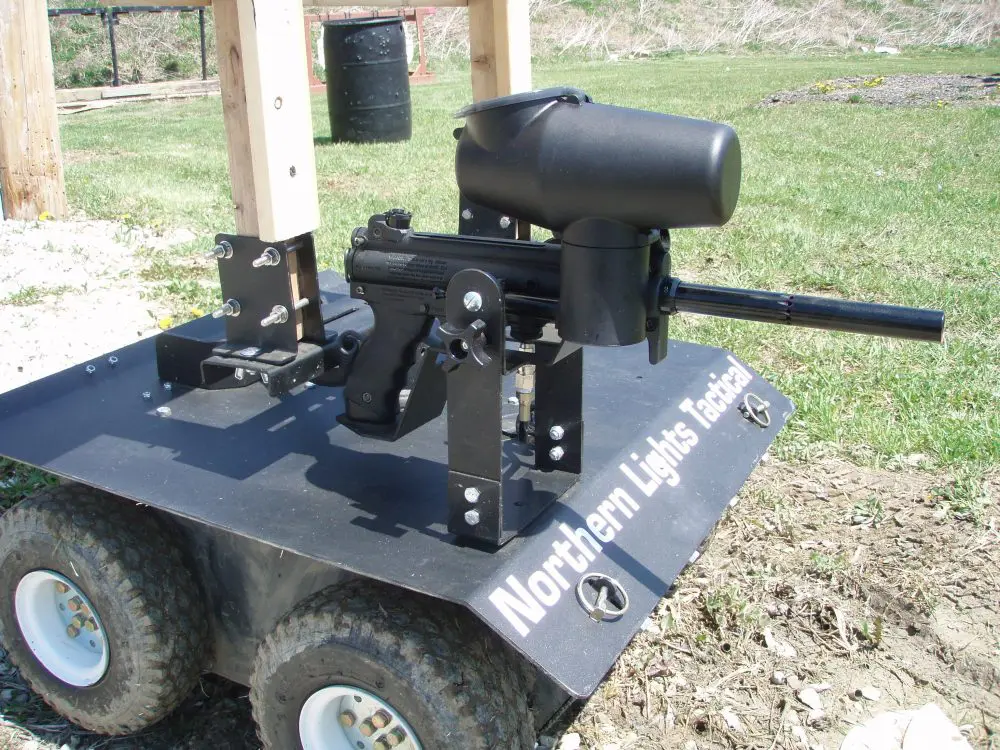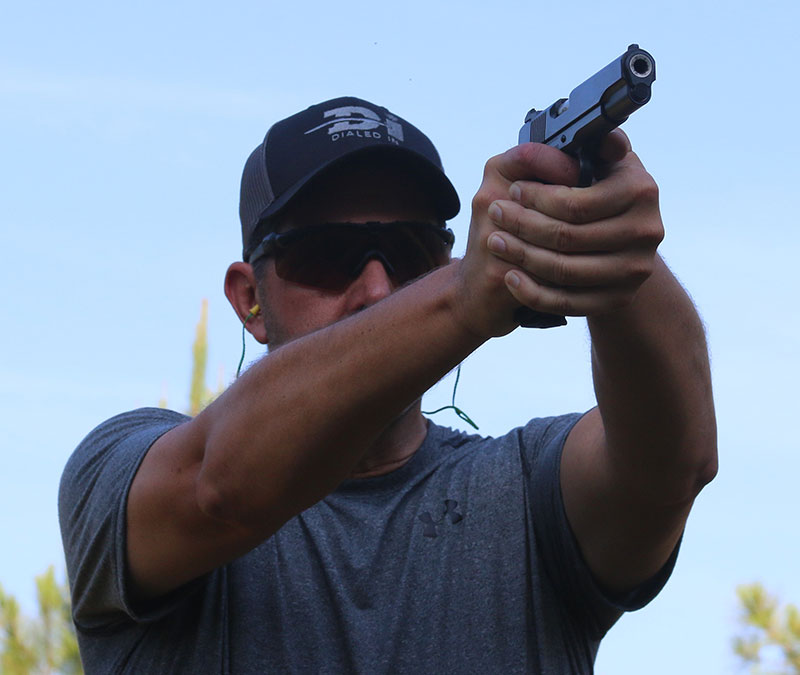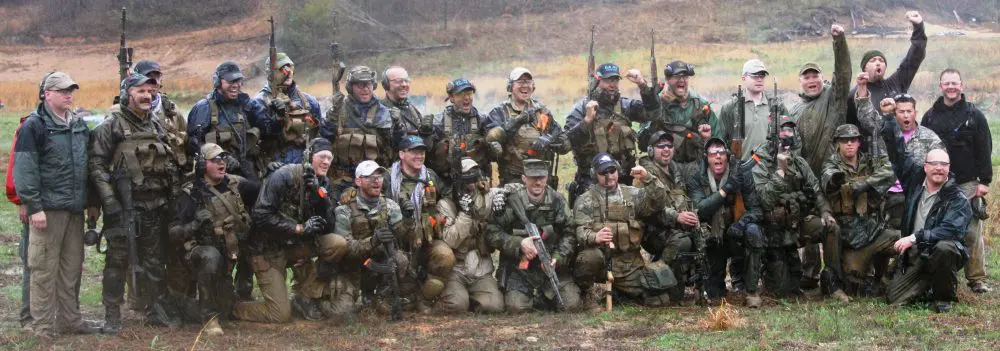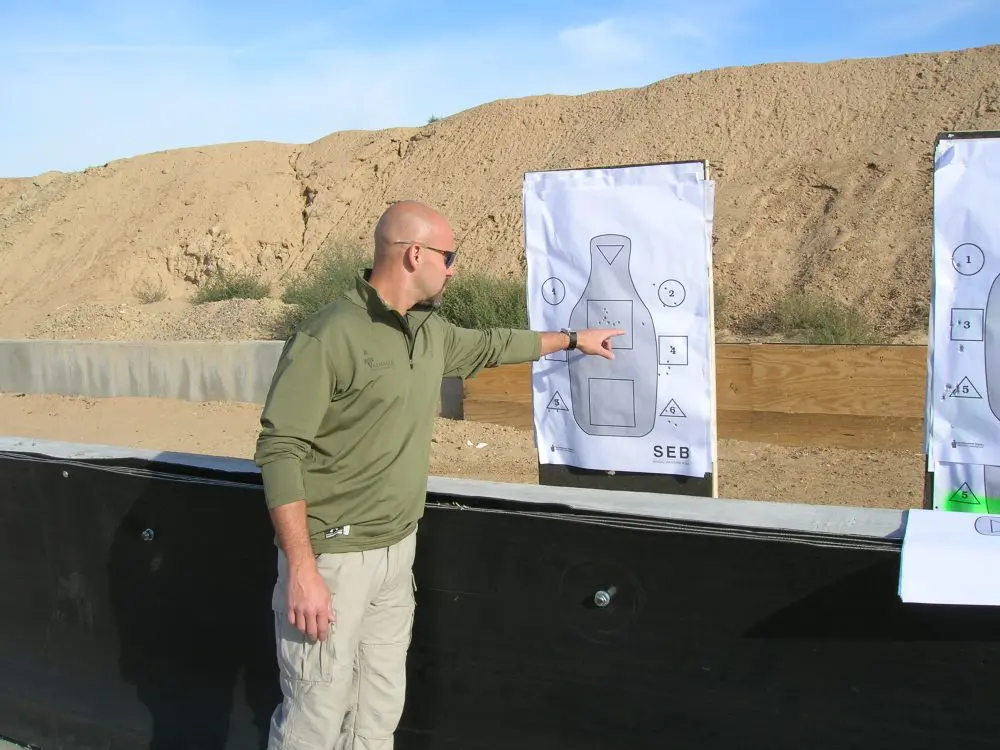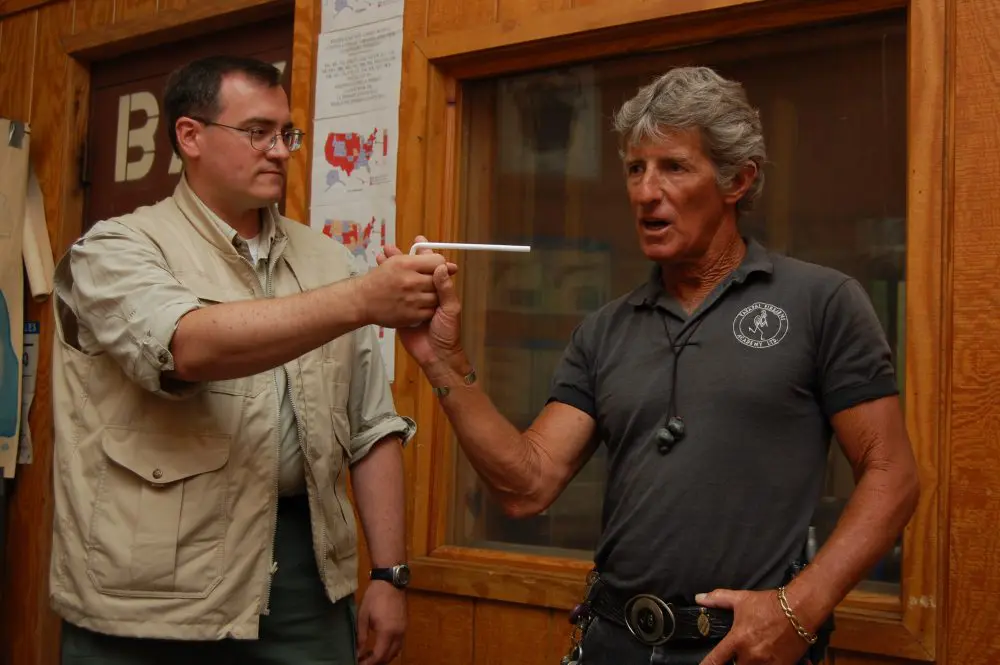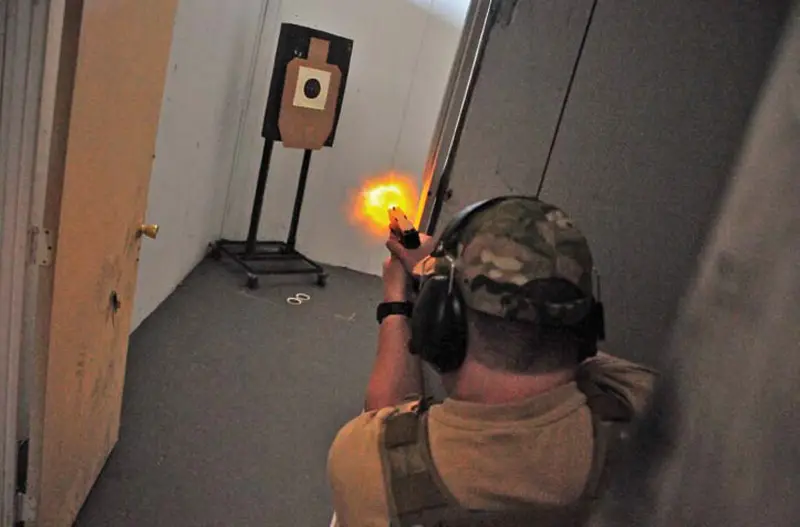
As I reflect back on my time in uniform, I realize how blessed I was to have served my community as a peace officer.
While cleaning out my file cabinet of all the LE paperwork I had accumulated over the years, I came across my training file. As I leafed through it, it dawned on me how many specialized schools I’ve attended. In the past three years alone, I have attended more tactical training than your average SWAT operator. Those who know me recognize that I seek to learn no matter where I go and am not so full of myself that I can’t say, “Please show me….”
In an effort to keep my edge, I went back to the drawing board and sought out training that would further hone my CQB skills. CQB isn’t just slicing the pie into a room in a slow and deliberate manner. It also means knowing what to do when slicing the pie isn’t an option. For learning that skill set, you have to go to a school with instructors who can teach CQB based on firsthand knowledge.
Few men have a resume like Larry Vickers, so with that in mind, I set out for the U.S. Training Center (USTC) in Moyock, North Carolina, where Larry and his company, Vickers Tactical, would be holding his MIL/LE CQB course.
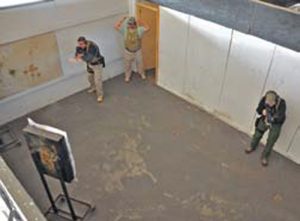
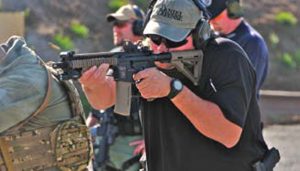
Table of Contents
THE BASICS
Larry is quite possibly the most intense person I’ve ever met. He doesn’t sugarcoat anything.
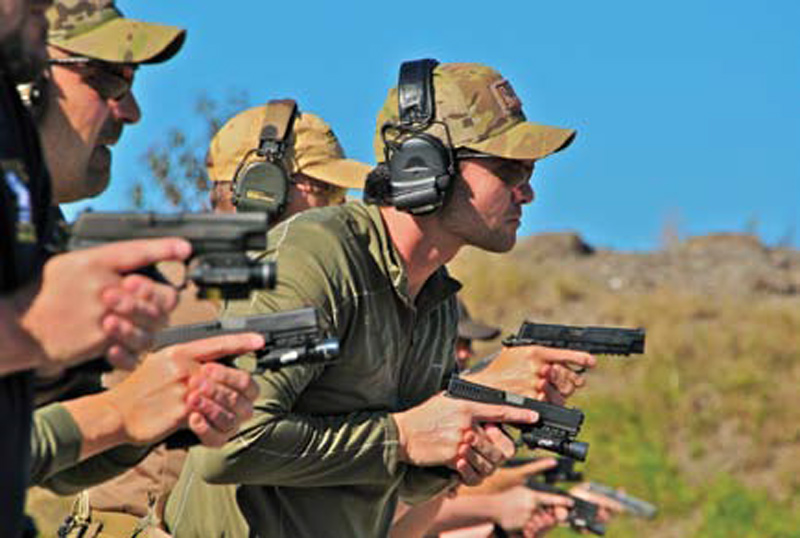
I’ve had the privilege of sitting at the knee of several superb instructors over the years, and Larry fits the mold of a master instructor. He not only teaches in a manner that the common man can understand, he also makes sure it goes into your head before moving on. For his MIL/LE CQB course, he reserved some space at USTC so as to properly teach this form of warfare.
In the CQB environment, there is precious little room for error, and Larry will literally put you into the wall if you screw up. On more than one occasion, he verbally flogged students who stepped outside the safety envelope and hotdogged their way through a room. But I’m getting ahead of myself. Let’s start on Training Day 1 and go step by step.
TRAINING DAY 1
Class began on a crisp November morning. As students were milling about in the parking lot of one of USTC’s many shoot houses and getting to know one other, Larry drove up and greeted us with his trademark “Whazup?” The new slimmed down Larry (60 pounds at last count) was looking fighting trim and full of energy. He quickly got us organized and onto the flat range for some pistol trigger work.
After a brief intro to the course, Larry had us moving through multiple drills with our pistols. For this class, I used a Glock 21 in .45 ACP shooting Black Hills 230-grain hollow point. As expected, both pistol and ammo functioned flawlessly.
TWO-MAN DRILLS
As soon as Larry had covered some basic information about the pace of the course and what was expected of us, we paired off into two-man teams. We took multiple turns pressing our triggers to the rear with an empty casing on the front sight. This was obviously done to see if we were doing what Larry calls the “El Snatcho.”
When you have to transition to your pistol in a CQB environment, you need to do so quickly, and without taking your rifle trigger-pull over to your pistol. That will cause a miss even inside a small room, as several of us proved during this three-day class. Next we did dot shooting with a timer to check our skills under mild pressure.
We then manually cycled the gun to get used to the breaking point of our triggers and to make sure we weren’t dipping the muzzle down at the moment of ignition. We also loaded up mags interspersed with empty casings to see if we were actually learning—and for the most part we were.
Next we practiced presenting the weapon from the holster to be sure we weren’t coming up too high on the threat and possibly launching one over its head.
We finished the morning with tactical reloads. Larry stressed the need to keep the gun up high in our workspace so as to keep our eyes on the threat. We were also advised to stow our partial mags anywhere but back in the mag holder. The last thing you want to do in a gunfight is reach for what you think is a full mag and find yourself pulling out one with only a few rounds in it.
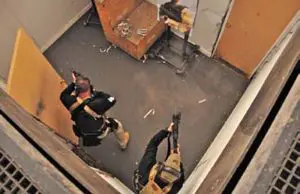
GEAR
The more training you attend, the more you’ll find efficiency of motion in your tasks. Subsequently you’ll learn to distill your kit down to only what’s needed.
Case in point: My standard concealment holster for many years has been a Blade-Tech open top with Stingray Loop belt slide adapter. While the Glock 21 is a very large pistol, it isn’t as hard to conceal as one might think. For this class I also used a Blade-Tech open-top dual mag holder.
I want to thank Blade-Tech for the lightning-fast turnaround time on this recent order. I purchased this kit at the 11th hour and they came through in just a few days to be sure I had what I needed for the class.
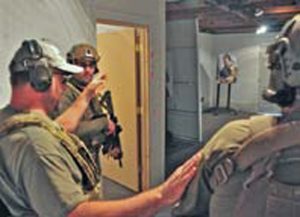
SHOOT HOUSES
After lunch, we met at one of the many live-fire houses that USTC has on site. This is where the basics we’d worked on were put to the test. Larry had repeatedly told us that any mistakes we saw on the range would be greatly exaggerated in the high-stress environment of the livefire houses—he was right.
People were throwing shots and were generally in a rush, all this even after we had made several cold runs. No matter how many times you tell yourself “this is only training,” there’s something about using live ammo along with picture targets that sucks you in every time.
The shoot houses at USTC are as close to a real home as you can get and still have modular environments that can absorb multiple rounds. Even though we were shooting at bullet traps that are rated to stop 5.56mm FMJ, we were required to bring frangible rifle rounds so as to preserve the life span of the bullet traps.
Black Hills Ammunition generously provided me not only .223 55-grain FMJ but also frangible 55-grain Barnes MPG. I was not aware that Black Hills made frangible ammo until this class. I’m glad they do, because by using their ammo at classes, I know I can relax and learn instead of fighting my ammo and gun. I have such faith in their QC that I would go into battle with their reloads. Each and every one of the rounds they sent me ran my carbine flawlessly. Even when I ran it in full auto a couple of times, it never once took a dump on me.
In these multi-room shoot houses, we learned how many ways you can screw up a room entry. Larry was teaching this class with the assistance of an active-duty SF operator. SF was very adamant about reminding us to stay close to the walls and keep our heads scanning so as not to get sucked into the perceived threats. Staying close to the walls also allows you a great field of view and makes it harder for a threat to get behind you in the chaos of CQB. Larry and SF expertly handled a large class of about 20 men and kept us from making any major mistakes.
We moved in two-man teams, with Larry and SF simultaneously working with a team on different sides of the house. But this was not spoon feeding— we were kept reined in for our own sakes. Being allowed to do something that normally doesn’t happen for military operators until they’ve run the live-fire houses dry for a week will give you a false sense of bravado.
SF told us he was pleased we were showing progress, but we were made aware that we were being shown just a small piece of the bigger picture. Even so, the class was thus far an eye opener regarding how I would deal with similar situations.
TRAINING DAY 2
As TD1 had begun, TD2 also began on the flat range. This time the carbines came out along with the pistols.
I was running a Daniel Defense MK18 Mod1 that was actually a T&E gun that had made the rounds from one U.S. Marshals office to another before coming to me. It was slightly gouged up and dirty when I got it. Perfect—I like guns I don’t have to be nice to. This rifle clearly had some mileage on it.
Upon its receipt, I set it up the way I like my SBRs to run. I’m an FFL/SOT machine gun manufacturer and have more experience with SBRs than I do with the 16-inch barreled variety. I’ve learned that these rifles are far more capable than people give them credit for. After several years of dedicated training with SBRs, I’ve come up with an equipment list and set-up that’s proprietary to myself. I’ve taken a fair amount of good-natured hazing from my fellow instructors for running this. I persist in doing so because I consistently get hits even when pushed out to the 300-yard line.
I have eight SBRs ranging from 7.5” barrels up to 11.5”. All of them are set up in the following manner: Magpul CTR, MIAD, Enhanced Trigger Guard, AFG and PMAGs. BCM gunfighter charging handle, KNS Precision Pin Kit, Norgon Ambi-Catch, SureFire X300, Troy micro battle sights, and Insight Technologies MRDS mounted low to the rail. The final two pieces of kit I add to an AR are a Daniel Defense Rear Receiver Carbine QD Swivel Attachment Point and singlepoint sling from Daniel Basham.
I got the MK18 set up and zeroed for the class. I hadn’t had the opportunity to test my chosen set-up in a truly dedicated CQB environment and was chomping at the bit to have a go.
GOING HOT!
Our morning of flat range carbine drills culminated in various confidence-building drills that demonstrated our ability to work closely and safely with our teammates.
The margin of error in a CQB environment is sometimes the distance between shifting your torso left or right. After that morning, I knew I was ruined for static training for the rest of my life. Exhilarating would best describe some of the confidence drills we did with our teammates.
After lunch, we met at the shoot house and broke up into two groups of teams that ran through the shoot houses with SF and Larry. My teammate was a bright young man named Lynn who was just going into LE. He and I had to learn very quickly how to work as a team. Both instructors kept us engaged and humble.
If you lost focus, you got an earful of very direct correction and an order to “get out of the room and set back up.” Time and time again, we all screwed the pooch and had to step out and start over. Larry and SF took ample opportunity to give individual instruction where necessary and group instruction as the standard before each drill.
Because USTC has catwalks built into most of their shoot houses, we were able to set up a “peanut gallery” where opinions could be voiced and issues hashed out. Whether it be technique or equipment, nothing escapes Larry’s watchful eyes.
As a writer/photographer, I got the opportunity to go through the shoot houses multiple times as a spectator. I ran each drill with my teammate, then slung the MK18, grabbed my Nikon and ran through the drills again and again while photographing each two-man team.
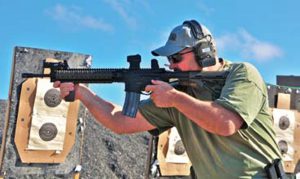
It was good for us to get chewed out by Larry and SF for our mistakes. I say this because this class forces you to pay attention to your shot placement. CQB has so many variables to keep track of that a moment of inattention can cost someone their life. For example, SF repeatedly reminded us that we needed to work our sector of the room. No matter what you see when you enter that room, if it’s not in your sector, you must trust that your teammate will do his job.
Larry would follow through with “Come on, you need to get six to eight feet inside that room. Otherwise you’re just sweeping into each other’s sectors!” “WTF was that? Don’t sweep closer than one meter to your partner!” In one instance, Larry looked at me as I was stacked up with Lynn and very directly asked, “Where’s your armor?” Oh crap! “Get your shit together, Abner!” I appreciated the militant nature of Larry’s instruction because I prefer direct verbiage to politically correct handling.
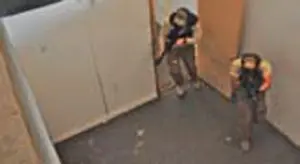
HALF SPEED
If I could take away only one thing from TD3, it would be the hard-learned lesson of paying attention to your surroundings. I would guess that the phrase “Keep your head on a swivel” derives from CQB operators.
This was manifested in my repeated mistake of not being right on my teammate’s tail when he moved into the room. Suffice it to say this was due in part to Lynn being jacked up on adrenaline and taking off like a shot when I would give him the “ready” shoulder squeeze. More than once I heard from Larry, “Hey Abner, why didn’t you follow your partner into the room? Do it again.” I took to calling Lynn “half speed” because that is what I started repeating to him just before I gave him the “ready.” But ultimately it’s my job to keep up with my point man—do or die.
By the end of the course, we were all very tired. Three-day classes allow you to really soak in the concepts. They also allow you to work out the kinks in your gear. But—they are absolutely exhausting.
FINAL THOUGHTS
During meal breaks, I had the opportunity to discuss training techniques and just general points of life with Larry and a couple of other notable gentlemen in the firearms industry who were fellow students.
Larry Vickers is my kind of guy. The manner in which he imparts instruction is severe, austere, and sometimes downright brutal. However, it is logically and simply presented. There’s no flash in the man, just steely eyed analysis of your every motion. You don’t have to worry about him pulling punches in his critique for fear of hurting your feelings.
At the end of the course, Larry and SF gathered us outside the shoot house for a final Q&A session. The class ended with a well-spoken warning to watch ourselves behind the wheel as we headed home because “you guys are more tired right now than you think you are.” That shows concern and a well-tempered knowledge that this sort of training is completely draining. Not only is it physically demanding, it is also emotionally exhausting to go up and down on adrenaline for three days straight.
I am very pleased I was able to attend this class. It has changed how I look at CQB techniques and made me wish I’d had this training while I was an activeduty cop. I know I speak for the class when I say thank you to Larry and SF for their superb instruction. I hope they will soon offer a Level II LE/MIL CQB Course.
